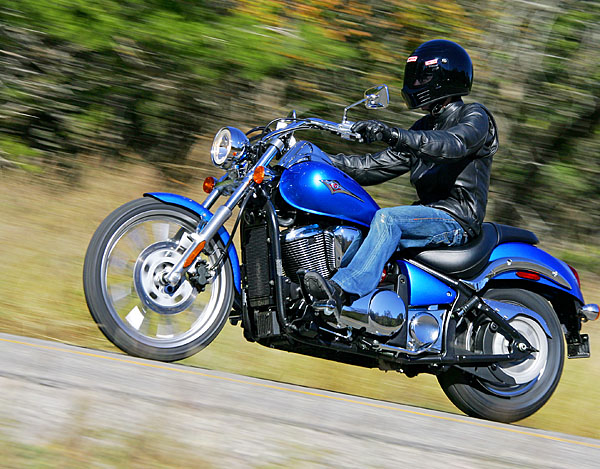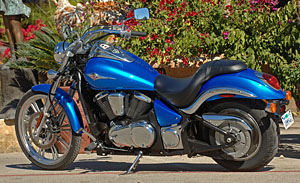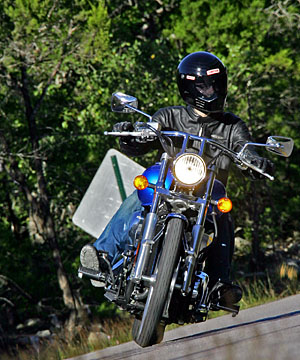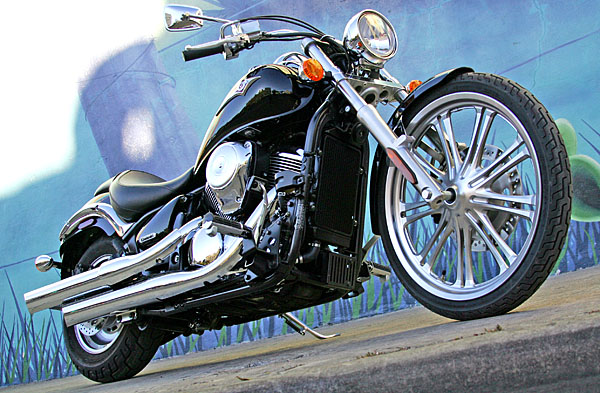2007 Kawasaki Vulcan 900

Every year, the big cruiser manufacturers move to make their range-topping cruisers bigger, badder, and bolder than the competition. Bikes like Triumph's Rocket III and Kawasaki's own Vulcan 2000 pack massive, torquey motors capable of easily outpacing the 1500cc bikes that were considered powerful just a few years ago. While these bikes will always appeal to those consumers whose vision of the 'American Dream' involves a vehicle that is bigger, faster, and more expensive than their neighbor's, a significant number of cruiser buyers are looking for something a little more practical. Rather than the heavy, expensive bikes at the top of the range, these consumers are looking for a well-balanced package that is easy and fun to ride, with light handling, adequate power (it's called cruising for a reason), and clean styling, all without breaking the bank. Buyers like this have been driving the continuing growth of the middleweight cruiser class for the last several years, a growth that most industry analysts expect to continue into the foreseeable future.
Back in March of this year, Kawasaki launched the Vulcan 900 Classic (and the 900 Classic LT, a faired and bagged touring model). While the Vulcan 900 doesn't pack as much displacement as some of the other current 'middleweights' (like the Star Motorcycles V-Star 1300 I recently reviewed), it strikes a good balance in size, weight, and rideability – remember, a few years back, a 1300cc cruiser would have been considered a 'heavyweight'. The Vulcan 900 Classic filled a gap in the market by offering a bike with the weight and handling characteristics more typical of a traditional 'small' (650-800cc) cruiser, powered by a water-cooled 903cc powerplant that packs as much power as many air-cooled 1100s, all wrapped in styling that gives it a 'big bike' look.

If you haven't figured it out yet, I liked the Vulcan 900 Classic quite a lot. Before you continue reading this review, you'll want to check out my review of the 900 Classic, since a vast majority of its features carry over to the new 900 Custom. In that review you'll find more info on the technical specs of the 903cc liquid-cooled V-Twin, as well as a more in-depth evaluation of its performance and character. Since the 900 Custom shares its motor with the 900 Classic, I'm going to concentrate on the areas where the two bikes are different – mainly, the chassis and styling.
Styling-wise, the 900 Custom maintains the 'big bike scale' of the 900 Classic, which helps ensure that a 900 owner won't feel embarassed parking his bike next to a row of 1500-1600cc machines. The rear tire is still a wide but reasonable 180mm, and the seat height is a still-low 27″ (.2″ taller than the 900 Classic).
The big difference between the two bikes is the 'Custom' look that gives the newer 900 its name. According to Kawasaki's designers, a true 'custom' design should be dynamic, with a visually 'light' front end and 'heavy' rear giving an impression of motion, even when the bike is parked. To create the light front, Kawasaki combined a number of elements, but the most noticeable is the cast-aluminum 21″ front wheel. In my opinion, this is one of the most attractive wheels ever offered on an off-the-showroom-floor cruiser, and I wouldn't be surprised to hear cruiser enthusiasts mistake it for an aftermarket piece. The tall, slender front wheel (carrying an 80/90-21 front tire, compared to the 900 Classic's 130/90-16) gives the front end a much more 'airy' look, which along with the smaller chrome headlight and drag style handlebars with integrated tubular risers, helps to emphasize the visually lightweight front end.
The rest of the bike was carefully styled, with the tank and rear fender sculpted in 3D to carry what Kawasaki calls the 'twin valley' theme. These 3-dimensional curves can be seen in photos, but to truly appreciate their effect, you'll have to check out a 900 Custom in person at your local dealership. The beefy rear fender sits low over the 15″ rear wheel with its 180mm wide tire, completing the 'light front, heavy rear' look. Finishing off the custom look are the forward foot controls, which replace the 900 Classic's floorboards to give what cruiser enthusiasts would call a 'semi-clamshell' riding position – hips back, legs and arms stretched forward.
The chassis is slightly different from that of the 900 Classic, with an additional degree of rake (33 degrees versus 32). The 900 Custom also features enhanced braking power, with a single 11.8″ (300mm) front disc squeezed by a twin-piston caliper, while a 10.6″ (270mm) disc is slowed by another twin-piston caliper out back. The bigger rear brake is important, since you won't be able to put much braking force through that skinny front tire.

And there's the rub, so to speak. The same feature that gives the 900 Custom its distinctive looks, namely the narrow, 21″ tall front wheel, compromises its handling when compared to the 900 Classic. While I wouldn't say the 900 Custom is a poor-handling bike by any means, it didn't give me the same secure, planted feeling from the front end that the shorter, wider wheel/tire combo on the 900 Classic did. The 900 Custom posseses additional ground clearance when compared to the 900 Classic (due to the absence of the Classic's floorboards), but I didn't feel comfortable exploiting that extra clearance to develop extra lean angle in the sweeping bends of the Texas Hill Country.
As long as I kept to a moderate pace, the 900 Custom was an excellent ride, although it does seem to prefer the rider to use a heavier helping of rear brake than I'm used to when coming to a stop (a consequence, as I mentioned earlier, of the skinny front tire). It was only when I started to push the pace slightly, probably to about the same pace that would have the 900 Classic dragging its floorboards, that I noticed the lack of front-end confidence. Probably not something that will be an issue for most buyers, then.
For all-day riding, the Custom is surprisingly comfortable, more so than you would expect from the forward-mounted foot controls. On a bike with such a low seat height, a long reach to the forward controls would be out of place, and the design team obligingly placed these forward controls far enough away to look cool, but not so far as to be an uncomfortable stretch. Judging by the amount of knee bend I had (I am 5'9″), a rider in the low 5′ range could probably reach the controls without trouble, although this all depends on inseam length. You should obviously try sitting on the bike and putting your feet up before you commit your cash.
The broad, flat 'drag-style' handlebars give plenty of control, and the seat is flat and comfortable, although a more pronounced rise at the rear to give more lower-back support would have made it even more so. Shorter riders will like the seat shape, as well – the seat is narrow at the front where it joins the tank, and the tank is equally narrow at this point, so sliding forward on the seat effectively gives the rider more leg length to reach the ground comfortably – useful in slow-speed manuevering, like when turning around in a limited space to make another photo pass (oops, journalist secret – yeah, it takes more than one try to get these cool pictures).

When I first laid eyes on the Vulcan 900 Custom, I was excited – come on, it's a much cooler-looking version of a bike I already really liked. Unfortunately, the 900 Custom doesn't offer the same fluid, confidence-inspiring handling of the 900 Classic. Still, it has the same excellent motor and transmission that provide all the power most cruiser riders will ever need, along with comfortable ergonomics and an excellent price. The two bikes emphasize different priorities — handling and looks. If I did a lot of straight-line highway riding and was mainly concerned about having the toughest-looking bike for my money, I would certainly consider a 900 Custom. If, on the other hand, I spent more time cruising through the canyons and mountains, I would choose the 900 Classic – still a cool-looking bike, but one with slightly superior comfort, and with handling that inspires more confidence despite the slightly poorer ground clearance.
The Vulcan 900 Custom carries an MSRP of $7,349 in the US. For more information, check out Kawasaki's web site.
You can follow any responses to this entry through the RSS 2.0 feed. Both comments and pings are currently closed.
Source: https://www.motorcycledaily.com/2006/11/28november06_900custom/

Tidak ada komentar: